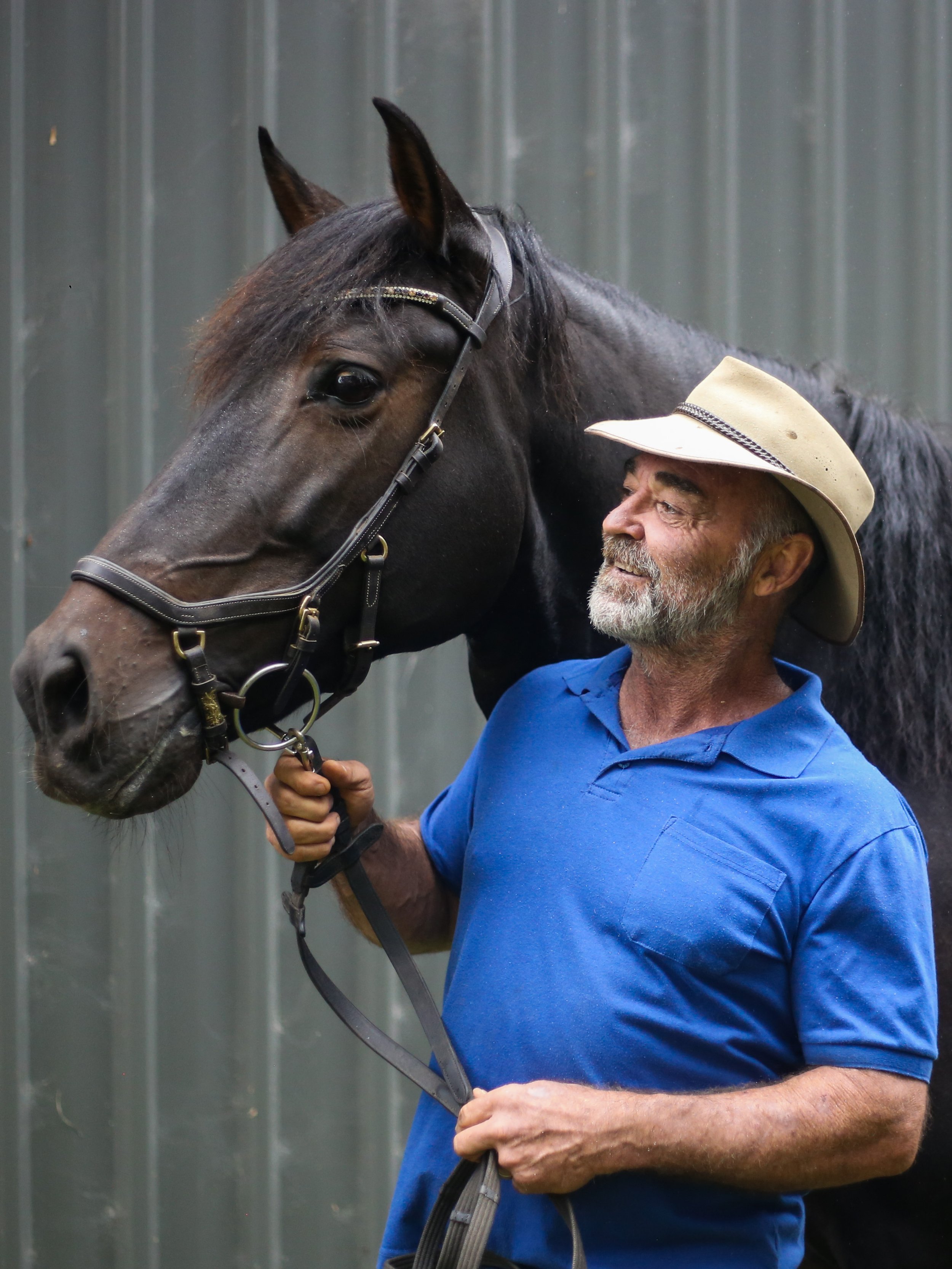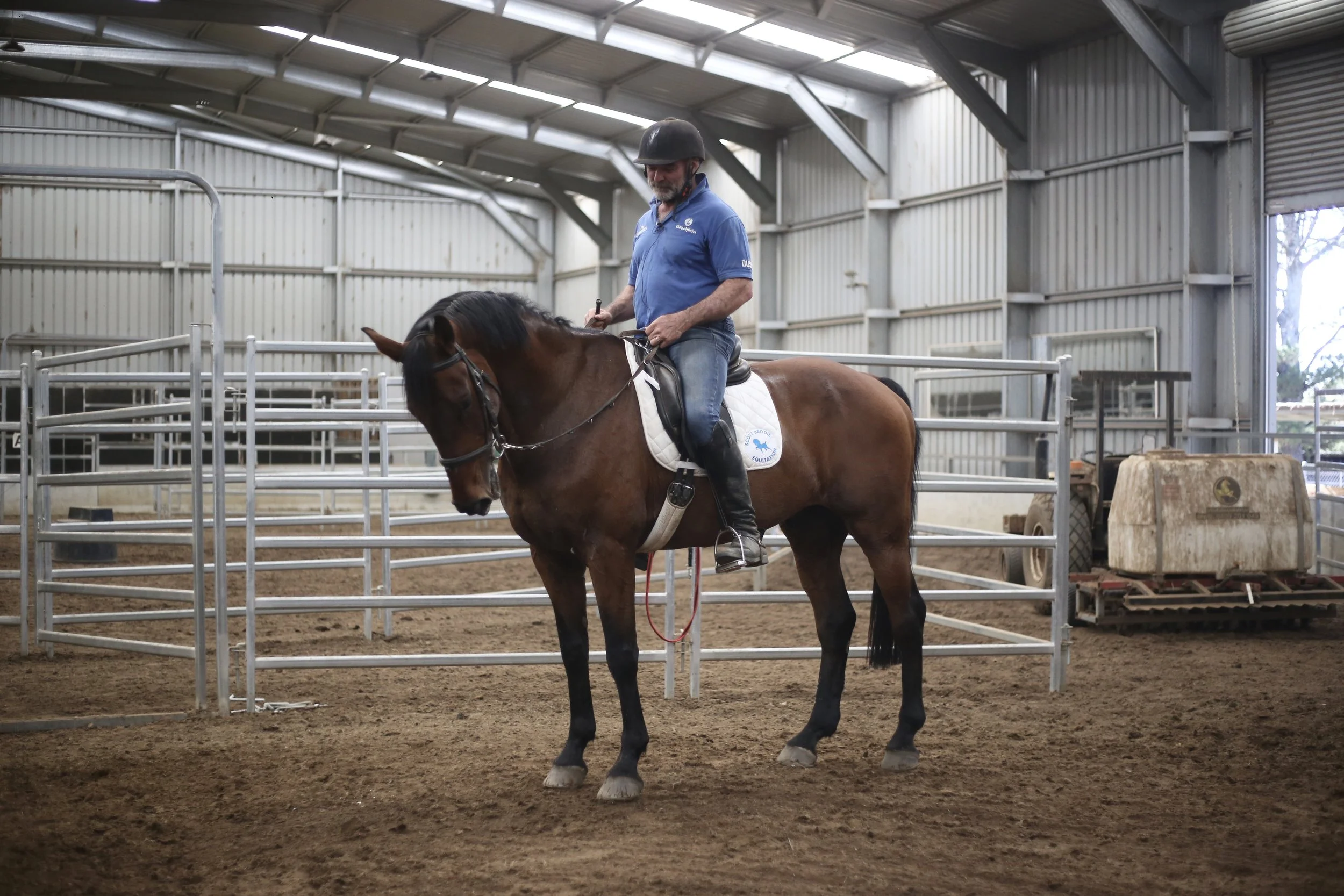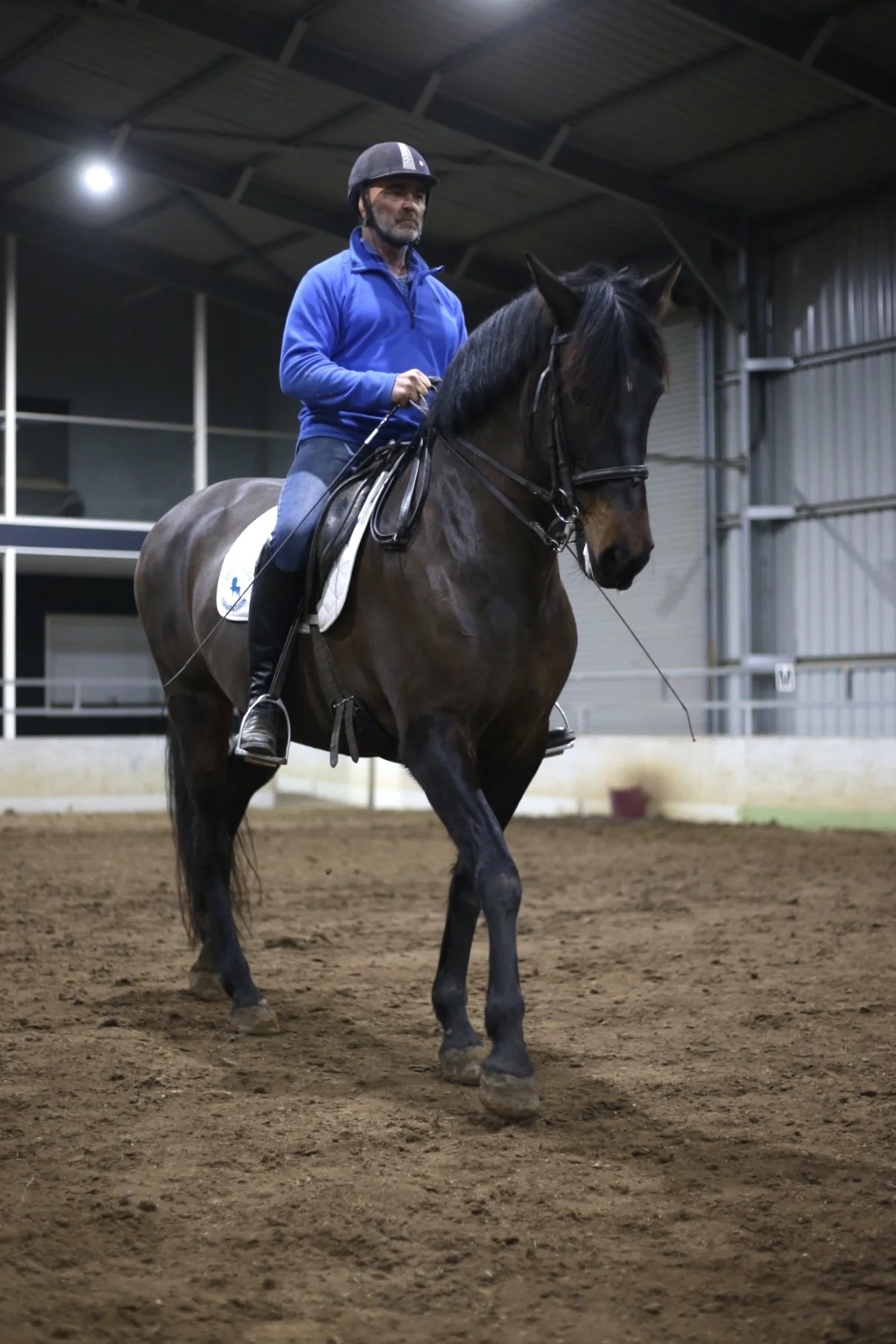Riding Under Pressure
Scott & Lulu - his homebred Andalusian mare
Does this sound familiar?
You’ve got the best horse in the world.
Four legs, two ears, a couple of eyes and a heart of gold.
You love spending time with them at home, but every time you load them into the float you discover it must be some sort of shapeshifting machine.
You put your dead quiet horse into it, and when you unload on the other side a totally different creature hurtles into the carpark - snorting, sweating and spitting green goop everywhere - seeming a lot more like a disgruntled rhinoceros than any kind of equine.
Whenever you go to a show, the grooming and tacking up phases include rivers of sweat (mostly from you - it is not easy trying to put a bridle on a baby dragon), but you always push through and manage to get yourself up on the saddle and into the warmup.
More often than not, the next thing you know you're sitting in the dirt watching your heart horse gallop about like it’s being chased by a swarm of invisible (but nonetheless incredibly angry bees), taking out your would-be competitors like bowling pins.
That or you manage to get through it, only to hang your head and try to fight back tears. Your horse is so amazing at home, but no one ever gets to see that.
Nearly every single person, across every equestrian discipline will have moments like these. You are definitely not alone. That’s just horses for you, right?
Well, Scott Brodie doesn’t think it needs to be that way - and he’s one of the few people in Australia who’s actually pretty qualified to hold that opinion, and been given awards to prove it.
Not only has he trained, ridden and helped hundreds of horses over the years, he knows all about riding under a the highest levels of pressure possible. Before he started training horses privately, he spent well over a decade teaching them how to be ridden into battle.
And yes... I do mean that quite literally.
Scott, can you run us through your equestrian career so far?
“I was in the NSW Mounted Police for 11 years (as a rider, trainer and instructor) before becoming injured in the line of duty one too many times and being deemed medically unfit. On retiring out I started training and teaching freelance, and started a business in the construction industry - unfortunately then I became badly injured during a Surf Club competition and had to let this go too.
While I spent weeks in hospital recovering, I saw that the Mounties were advertising for external trainers to produce police horses to boost patrol numbers, so once I was able to return to work I started bringing on horses for them as a contractor instead.
After this I was approached by the Australian Turf Club who were looking for someone to train horses for a mounted security team for concerts and race days. We started off with ex-Mounties and my own horses (a bunch of Andalusians I was using as school horses), but quickly started using thoroughbreds as they had a good supply of them. We retrained more than enough for the mounted security team, but they kept giving us more horses, so we started training them for new homes instead. Eventually Racing NSW saw what we were doing and decided to employ us directly and give us a facility of our own - that’s how the Thoroughbred Retraining Program (now known as Team Thoroughbred) started. Now I work privately from my own facility, using my own mix of classical dressage and natural horsemanship to train horses of all breeds, abilities and ages. I also coach at lessons and clinics both here, and across the country.”
I’m sure a lot of people know you from your work with ‘off the trackers’ - was that always something you had a passion for?
“I just fell into retraining thoroughbreds. You know, when I started at the Mounted Police, the standard issue was Thoroughbred, 16hh+, bay, black or brown. There was nothing else. And you know, we’d be riding these young horses on the streets, and certainly to begin with there was a lot of pressure to get them out on the streets quickly. They wanted us to find out if they were good or not - to see if they were worth retraining properly. I got hurt a few times, and realised it was better to train them to a good standard first and then take them out on patrol to see if they could handle it. Besides - if they couldn’t, we could find a better homes for them.
If they’ve come from the racing you’ve got to un-train what they’ve learned from that world before you can start re-training them for anything else. I use my blend of techniques to reprogram them to reintegrate into society and give them a solid foundation for a second chance.”
How do you fix a ‘stress-head’ horse?
“Education.
You have to go all the way back to the beginning and build a new, solid foundation. You’ll find where the problems are along the way, and it will add tools to your toolkit for problem solving if you find yourself in difficult situations later on. If you can’t solve problems at home, you won’t be able to work through them while you’re out there competing.
Dont over-face yourself and take your time with the training — you’re far better of competing at a lower level than where your training is at when you’re at home. Only go to a competition if you feel confident in asking the horse to rise to challenges at home, and go there being 100% willing to walk away if it’s the right thing to do. If you can be bold and brave enough to unload your horse, walk it around for a while and then load it up and take it home because you realise its not going to end well; then you’re in the right headspace to compete.
You have to always be willing to do the right thing by the horse, even if it means swallowing your pride.”
Can you give us an example of a stressful situation you’ve ridden into?
“I can give you a decades-worth. I’ve ridden horses into crowds, slippery surfaces, up and down stairs - but I think the scariest thing I’ve ever had to ride into was really bad riot situation.
I’m talking people throwing bricks, and us having to ride our horses in there because it was the only way to get the other cops (on foot) out alive. It’s incredibly stressful trying to make decisions about the safety of you, your horse, fellow officers and the general public around you.”
How on earth do you train a horse to handle that kind of pressure?
“Same as any other - you train them systematically. You never over-face them, but just give them a problem they can handle and then add a slight degree of difficulty until they’re comfortable with that, then add in the next step.
You gently, consistently teach them a new language - one where they understand that you’re asking a question, and they’re to give you the best answer they can.
You never want to overwhelm your horse, you need to be consistent so that they can be confident in themselves, their education and you. Once a horse is educated it can stay calm and relaxed, and you can ride an educated horse into any situation. Into a riot, grand prix dressage, top level eventing - to them it’s the same.
Theres a lot of discussion about desensitising horses, especially off-the-track ones. Habituation is an important asset, but education should always be the priority. I’ve had the most bomb-proof police horses have a meltdown because someone’s put a new mounting block in their arena. It’s something unfamiliar in their ‘safe’ place. If you educate a horse correctly, you’re proving to them every step of the way that YOU are the safe place. With you, they can relax and take on guidance no matter the situation.
Having a good education means that the horse is engaged, mentally as well as physically, and they will have to disengage before they can ‘act out’. If your horse has a good training, then relaxation is always the reward, and you can quickly bring them back to a place of relaxation by training a conditional reflex - giving them a thing to do with their body that feels familiar and their minds will follow that. Working them in hand is also invaluable for this.”
And how do you train yourself to cope with riding under stress?
“We have to understand that our job is to be what makes the horse comfortable. You have to know what you're doing and be confident about problem solving with
the horse. It’s also important to be able to control your emotions and carry out your side of the partnership, regardless of the environment. You need to be confident in your abilities, and be able to mentally rehearse the situation before it happens. If you were a dressage rider, you'd need to be able to know how you want your test to feel, and each movement. You need to develop skills around coping with pressure, and confidence in the face of adversity - these things take time and come with experience. It’s hard sometimes, but one of the most important things is that you need to be humble, and ask for help. Everyone should ask for help - I still have lessons! And I’m always reading, always talking to people when I run into new challenges.”
Any recommendations?
A Blueprint for the Serious Rider by Miguel Tavora, Steinbechs Gymnasium of the Horse, Horses Were Made to be Horses by Franz Mairinger and Ecole de Cavalier by Francois La Guérinière.
How do you know when you need to get help, and go about finding the right person to help you?
“As soon as you are in a situation and you don’t have a solution for it, try to find help. Books and the internet are great if you can find the information, and have the confidence to follow it - but nothing is going to beat a good mentor.
Find someone who’s ridden a variety of horses in a variety of situations, and done well. If they’re a rider, you want a rider who can problem solve. A good trainer will be able to explain how they work, and why they work that way - you need someone that isn’t going to just give you instruction, but the explanation that goes along with it. You want them to be able to help you not just with the horse, but the whole situation.”
Proudest moment on a horse?
“Every day is a proud moment for me. Whether I’m competing at a high level, or riding a young horse that’s had difficulties in working things out and is finally coming through them - every time a horse comes into a situation and stays relaxed I am overwhelmed with pride for them.”
Any parting wisdom for the horse world at large?
“We’re starting to have a good idea, universally, about mental health in people and the effects that has on our physical health. I think we really need to start doing the same with horses. We need to do the right thing by the horse, so they can be physically and mentally prepared for their whole lives - not damaged.”
I’d like to thank Scott for his time today by letting you know about his most recent adventure; becoming a movie star. His debut - a feature-length documentary about the charity he runs to save both off-the-track racehorses and returned defence force personnel by helping them to heal each other - is going to be premiering across the country later this year. If you’d like to see the amazing work they do, and stay up to date with the release, you can find @HORSEAID or @THE HEALING DOCUMENTARY on Instagram or via their websites.





